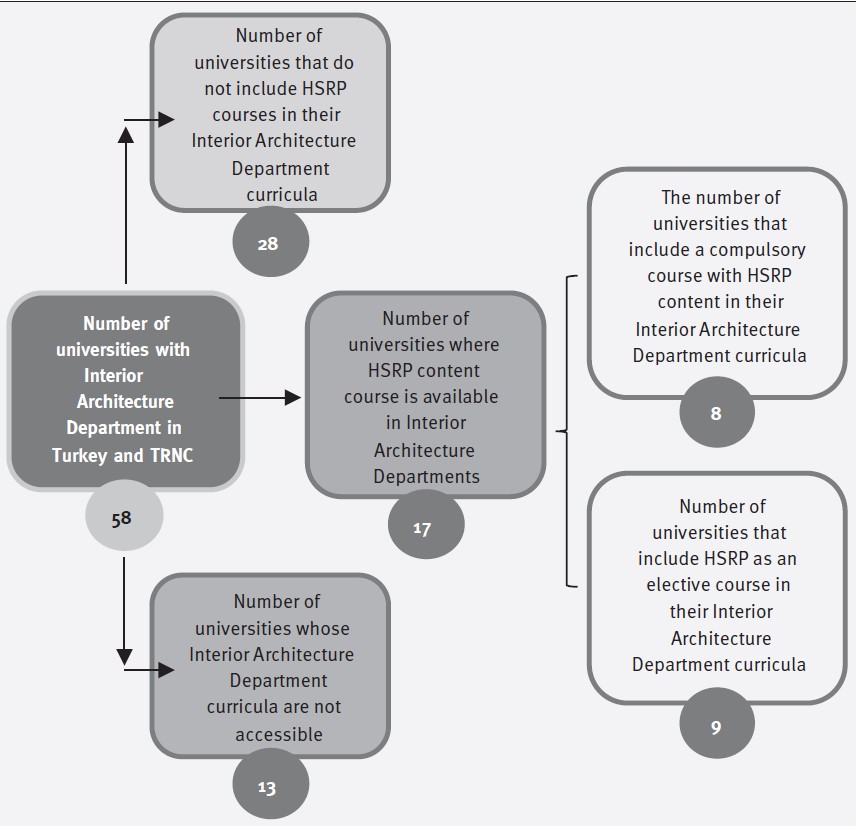The Role and Significance of Human-Space Relationship and Psychology in Interior Architecture and Architectural Education
A Proposed Training Model
DOI:
https://doi.org/10.31522/p.32.1(67).8Keywords:
architectural education, environmental psychology, human-environment relationship, human-space relationshipAbstract
Each geographic location has its own unique architectural language and characteristics. Therefore, it is important to acknowledge that architectural design cannot be universally suitable for every geography. To be able to think, calculate, evaluate and analyse all these and more at every scale is possible with ‘human-space relationship and psychology’ (HSRP). For this reason, HSRP seems to be a lerning necessity for architecture students, especially interior architecture departments, in undergraduate education processes. The study started by determining the position of architecture and interior architecture education and HSRP in undergraduate education. Based on the findings obtained and analysed, an education model on HSRP was developed and applied to interior architecture and architecture undergraduate students in three different academic terms. The HSRP education model combined theoretical subjects and activities, and the students’ cognitive levels were measured at the beginning and end of the academic term. Quantitative data demonstrated that the developed education model made the subject more comprehensible to the students compared to a purely theoretical approach. This emphasised the importance and necessity of the course.
References
Adıgüzel, D. (2011) Türkiye’deki İç Mimarlık Eğitiminde Çevresel Yaklaşım. Published master’s thesis, Kadir Has University, İstanbul [online]. Available at: https://tez.yok.gov.tr/UlusalTezMerkezi/tezDetay.jsp?id=3fV48ibHbTAr-jw99GArYw&no=EXQWsjd-bMBfKqZkjXK_QQ [Accessed: 22 April 2023].
Aygenç, B. (2020) Kullanıcı Açısından Mekân Aidiyeti ve Yaşam Çevresinin Psikolojik Etkilerinin Samanbahçe Konutları Örneğinde İncelenmesi. Published master’s thesis, Near East University, Nicosia.
Aygenç, B.; Özburak, Ç. and Uzunoğlu, S.S. (2020) Investigation of Place Attachment and Sense of Belonging from the Perspective of the Residents - Samanbahçe Social Residences as Case Study. Amazonia Investiga. 9(32), pp. 91-107, https://doi.org/10.34069/AI/2020.32.08.10
Bechtel, R. and Churchman, A. (2002) Handbook of enviromental psychology. New York: Jhon Wiley and Sons Publishing.
Bell, P.; Fisher, A. and Baum, T.G. (1996) Environmental psychology. Fort Worth: Hercourtbreace College Pub.
Bonaiuto, M. and Bonnes, M. (2000) Socialpsychological approaches in environment-behavior studies. Theoretical perspectives in environment-behavior research (67-78). Springer, Boston, MA. https://doi.org/10.1007/978-1-4615-4701-3_7
Bozdayı, A.M. (2004) İç mekân ve insan. Ankara: AJANSMAT Printing Press.
Devlin, A.S. (2018) Environmental Psychology and Human Well-being: Effects of Built and Natural Settings. Cambridge: Academic Press. https://doi.org/10.1016/B978-0-12-811481-0.00001-9
Draper, J. (2000) The architect: chapters in the history of the profession - The ecole des beaux-arts and the architectural profession in the United States: the case of John Galen Howard. Los Angeles: University of California Press.
Eriş, E. and Ağan, M. (2020) Türkiye’deki İç Mimarlık Eğitim Programlarının Karşılaştırılmalı Analizi Mesleki Kimlik Karmaşasının İncelenmesi. Journal of Architecture and Life, 5(2), pp. 423-439 [online]. Available at: https://dergipark.org.tr/tr/pub/my/issue/57609/794120 [Accessed: 27 November 2023]. https://doi.org/10.26835/my.794120
Gifford, R. (2007) Environmental psychology: principles and practice. Colville, WA: Optimal Books.
Göka, Ş. (2001) İnsan ve mekân. İstanbul: Pınar Publications.
Göregenli, M. (2010) Çevre psikolojisi (insan – mekân ilişkileri). Istanbul: Bilgi University Publishing.
Junot, A.; Paquet, Y. and Fenouillet, F. (2018) Place attachment influence on human well‐being and general pro‐environmental behaviors. Journal of Theoretical Social Psychology. 2(2), pp. 49-57. https://doi.org/10.1002/jts5.18
Kopec, D. (2006) Environmental Psychology for Design. New York: Fairchild Books.
Lynch, K. (2010) Kent İmgesi. Istanbul: Turkiye Is Bankası Publishing.
Mert, S. (2019) Environmental psychology discourse in architecture: Current status in turkish architecture education. Published master’s thesis, Middle East Technical University, Ankara.
Roth, L.M. (2007) Understanding architecture: its elements, history and meaning, 2nd Edition. Cambridge: Westview Press.
Sadri, H. and Zeybekoğlu S.S. (2013) Özgürleştirici mimarlık eğitimi. Journal of Critical Pedagogy, 28, pp. 60-66.
Saraf, M. (2013) Türkiye’de iç mimarlık eğitiminde aydınlatmanın yeri ve önemi. İstanbul: Okan University [online]. Available at: http://www.emo.org.tr/ekler/ca89a85612b8e45_ek.pdf [Accessed: 19 October 2020].
Sevinç, Z.; Çakır, O. and İlal, M.E. (2015) Türkiye’deki iç mimarlık eğitiminde yapı fiziği dersleri. Interior Architecture Education 3rd National Congress. Congress book, pp. 1-14.
Solak, G.S. (2017) Mekân - kimlik etkileşimi: Kavramsal ve kuramsal bir bakış. MANAS Journal of Social Studies, 6(1), pp. 13-37.
Uzunoğlu, S.S. and Özer, H. (2014) Mimarlık eğitiminde mimari psikoloji formasyonunun geliştirilmesi için bir model. Megaron, 9(2), pp. 143-165 [online]. Available at: https://jag.journalagent.com/megaron/pdfs/MEGARON-39974-ARTICLE_%28THESIS%29-UZUNOGLU.pdf [Accessed: 2 February 2020].
Wilton-Ely, J. (2000) The architect: chapters in the history of the profession - The rise of the professional architect in England. Los Angeles: University of California Press.

Downloads
Published
How to Cite
Issue
Section
License
Copyright (c) 2024 Beren Aygenç, Cimen Özburak

This work is licensed under a Creative Commons Attribution 4.0 International License.
Copyright (c) 2021 authors and journal.
This work is licensed under a Creative Commons Attribution 4.0 International License.
Authors who publish with this journal agree to the following terms:
In agreeing this form, you certify that:
- You read the ethical codex of the PROSTOR available at journal web.
- You submitted work is your original work, and has not previously been published and does not include any form of plagiarism.
- You own copyright in the submitted work, and are therefore permitted to assign the licence to publish to PROSTOR.
- Your submitted work contains no violation of any existing copyright or other third party right or any material of an obscene, libellous or otherwise unlawful nature.
- You have obtained permission for and acknowledged the source of any illustrations, diagrams or other material included in the work of which you are not the copyright owner.
- You have taken due care to ensure the accuracy of the work, and that, to the best of your knowledge, there are no false statements made within it.
- All co-authors of this submitted work are aware of, and in agreement with, the terms of this licence and that the submitted manuscript has been approved by these authors.






